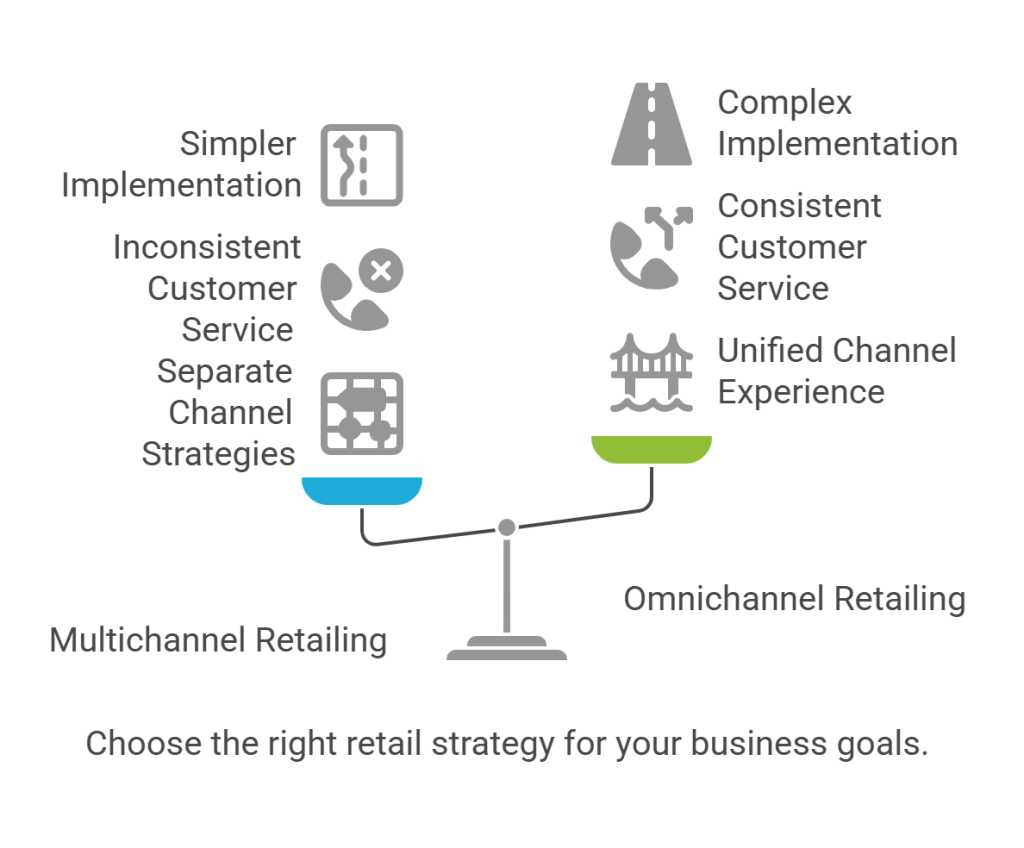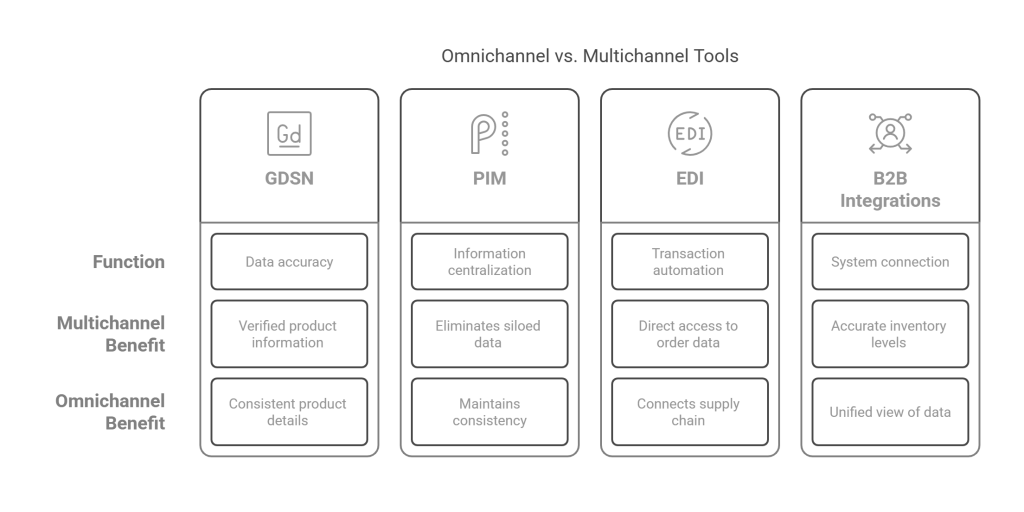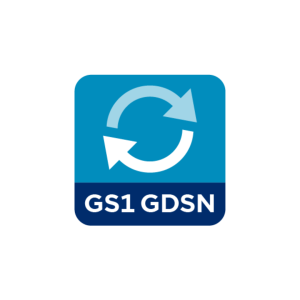Introduction
Retailers today face a crucial choice between omnichannel and multichannel strategies. Modern consumers expect their brand experiences to stay consistent across every touchpoint – 75% of them to be exact. Our research reveals something even more striking: using three or more channels can boost order rates by 494%.
The difference between omnichannel and multichannel retail approaches stands out clearly. Multichannel retail keeps separate strategies for different platforms. Omnichannel retail creates one unified customer experience, whatever platform shoppers use to connect with your brand. This fundamental difference shapes customer loyalty, revenue growth, and market share significantly. To cite an instance, see how integrated approaches help companies boost sales by giving customers multiple buying options that match their specific needs.
This piece breaks down the core differences between omnichannel and multichannel ecommerce strategies. It also showcases real-life examples from top retailers who’ve made these approaches work. You’ll learn which model fits your business best and how to utilize the right technology to give today’s consumers the uninterrupted experience they just need.
My Personal Story as a Shopper
A few months ago, I decided to buy a sound bar. Like most shoppers today, my journey started online. I browsed through various retailer mobile apps—Best Buy, Walmart, Amazon, and Canadian Tire—comparing prices, brands, and features.
However, I’m the kind of shopper who likes to experience electronics in person before making a purchase. Especially for something like a sound bar, I want to see it, feel it, and hear its quality firsthand. That’s where Amazon fell short for me—no physical stores meant I couldn’t test the product.
So, I took my research offline and visited the nearest Best Buy, Walmart, and Canadian Tire stores. I walked in with a wish list I had built from my online research. To my surprise, both Best Buy and Canadian Tire were offering the exact same prices and promotions across all their channels—in-store, on their websites, and in their mobile apps.
But at Walmart, I noticed something different. The in-store price was actually better than what I saw in the app. That sealed the deal for me—I bought my sound bar from Walmart. It was the brand I wanted, within my budget, and offered the best value for my money.
What this experience taught me is that, as a shopper, I truly rely on both multichannel and omnichannel experiences to make my final decision. And I’m not alone. I saw many other customers doing the same thing—checking their phones in-store, comparing deals, and cross-referencing information before buying.
This, to me, is the future of shopping. We expect multiple touchpoints to be available—online and offline—so we can make informed decisions that combine convenience, price, quality, and experience.
Omnichannel vs Multichannel Retailing: Definitions and Key Concepts

The difference between retail strategies is more than just words. Retailers need to understand these concepts to develop the right approach that matches their business goals and customer expectations.
Multichannel: Multiple Channels, Separate Strategies
Multichannel retailing sells products through independent channels of all types—websites, physical stores, mobile apps, and marketplaces. This strategy treats each platform as a separate entity with its own operations and objectives. The channel-focused approach puts product visibility ahead of unified experiences and has minimal data synchronization between platforms.
This strategy gives consumers more buying options and maximizes exposure. Research shows multichannel approaches have a 90% higher customer retention rate than single-channel strategies. The model creates inconsistent pricing, promotions, and customer service across different touchpoints.
Omnichannel: Unified Experience Across All Channels
Omnichannel retailing merges all channels to create a smooth shopping experience. Unlike multichannel separate operations, omnichannel connects channels directly so they complement each other—online activities shape in-store experiences and vice versa. Customers come first in this approach, not the channels. Every touchpoint offers consistent ways to buy products, get service, and receive individual-specific assistance.
A customer might research an item online, check inventory at a local store, and buy it in person—their entire experience stays connected throughout. This needs live synchronization of customer data, product information, and inventory across all channels.
Why the Difference Matters in Retail
The choice between these approaches affects business operations and customer relationships a lot. About 73% of shoppers use multiple channels during their shopping experience. Retailers must align their strategy with changing consumer behavior.
Multichannel is simpler to implement but can create disconnected experiences. Omnichannel builds deeper customer relationships through personalization but needs more tech investment and operational coordination.
Modern consumers expect unified experiences—about 75% want consistency wherever they shop. About 70% of consumers say technology makes it easier to switch businesses if they don’t meet expectations.
Choosing the Right Strategy: Factors Retailers Consider
Choosing between omnichannel and multichannel retail approaches relies on several key factors that change with each business situation. Companies should carefully assess these elements before picking their strategy.
Customer Expectations and Behavior Trends
Modern shopping patterns clearly show what customers want. Research shows that 67% of shoppers start on one device and finish on another. This highlights why smooth cross-device experiences matter so much now. Customers expect consistent brand messages at every point of contact.
Companies that provide quality omnichannel experiences see customer satisfaction rates 33% higher than their competitors. Numbers back this up – omnichannel retailers keep 90% more customers than stores using just one channel.
Product availability tops the list of concerns for both women (90%) and men (87%) before they buy online. This move toward combined experiences shows how digital advances have altered the retail map.
Operational Complexity and Internal Readiness
A company’s current setup often determines which strategy works best. Omnichannel offers better integration but needs significant technology investment.
Companies must look at their current abilities in:
- CRM and ERP systems integration
- Cross-channel inventory management
- Unified commerce platforms
- Personalization engines
Unlike multichannel’s separate systems, omnichannel needs advanced technology to sync data, inventory, and communication channels. Companies with tight budgets might start with multichannel, which offers more flexibility while delivering solid results.
Scalability and Long-Term ROI
Money matters go beyond setup costs. In fact, just a 5% boost in keeping customers can increase profits by 25-95%. Using three or more channels helps companies involve customers 250% more than single-channel approaches.
Omnichannel retail’s combined system supports efficient operations by cutting duplicate work.
All the same, your brand’s goals determine the final choice. Brands focusing on reaching more customers might prefer multichannel, while those wanting to offer tailored experiences usually do better with omnichannel approaches.
Comparison Table - Multichannel vs Omnichannel
Aspect | Omnichannel | Multichannel |
|---|---|---|
Core Definition | An integrated approach that creates a unified shopping trip through all channels | Multiple independent channels that operate separately with different goals |
| Customer Experience | Uninterrupted, consistent experience at all touchpoints | Different experiences for each channel with minimal integration |
| Data Integration | Up-to-the-minute synchronization of customer data, inventory, and product information | Limited data synchronization between platforms |
| Customer Retention | 90% higher customer retention than single-channel | 90% higher customer retention than single-channel |
| GDSN Usage | Will give a similar product details display at all touchpoints | Makes managing separate channel operations easier with verified product information |
| PIM Implementation | A single source of truth for all product content with simultaneous updates | Helps manage product information through separate channels |
| EDI Application | Links the whole supply chain cycle for a smooth customer trip | Gives direct access to order data through separate channels |
| B2B Integration | Builds a unified view of inventory and customer data | Keeps accurate inventory levels through independent channels |
| Example Retailer | Target: Smooth physical-digital integration with unified app, store, and online experience | Amazon: Mainly multichannel marketplace with some omnichannel features |
| Implementation Complexity | Higher complexity, needs substantial technology investment | Lower complexity, faster implementation |
| Channel Coordination | All channels blend with integrated operations | Channels work independently with separate strategies |
| Data Synchronization | Complete up-to-the-minute synchronization through all channels | Limited or no synchronization between channels |
Tools That Support Omnichannel and Multichannel Execution

The right technological backbone determines retail strategy success. Every successful retail operation needs specialized tools that make shared data flow and customer experiences consistent, regardless of whether it’s omnichannel or multichannel.
GDSN: Ensuring Accurate Product Data Across Channels
The Global Data Synchronization Network (GDSN) builds the foundation for data accuracy in omnichannel vs multichannel retail. Trading partners can exchange standardized product information through this interconnected network globally. GDSN works on a publish-subscribe model where brands add product data to one pool that retailers can access.
GDSN makes managing separate channel operations simpler for multichannel retailers by providing verified product information. Omnichannel retailers use GDSN to display similar product details consistently across all touchpoints. GDSN performs over 10,000 data quality checks to eliminate inconsistencies that hurt customer trust.
PIM: Centralizing Product Information for Consistency
Product Information Management (PIM) systems serve as the central nervous system in retail data strategies. The global PIM market value stood at $9.90 billion in 2019 and will reach $59.25 billion by 2027. These numbers highlight PIM’s vital role in modern retail.
PIM offers a single source of truth for all product content and supports complex omnichannel strategies. Retailers can eliminate siloed data that affects multichannel approaches through centralization. The system updates all channels at once to maintain consistency in product descriptions, specifications, pricing, and digital assets.
EDI: Automating Transactions Across Retail Partners
Electronic Data Interchange (EDI) makes business transactions smooth by enabling the electronic exchange of purchase orders, invoices, and shipping notices. EDI messages take seconds to exchange, unlike manual processes. This speeds up order processing and improves cash flow.
EDI gives business managers direct access to order data across separate channels in multichannel environments. This makes analysis and forecasting easier. EDI connects the entire supply chain cycle for omnichannel retailers—from procurement to shipping and order management—creating a smooth customer experience.
B2B Integrations: Connecting Systems for Real-Time Sync
B2B integrations connect different business systems together. These connections sync product data, inventory, and orders between retailers and their partners in real time. Hybrid B2B integrations help multichannel retailers maintain accurate inventory levels across independent channels. Omnichannel retailers utilize these integrations to create a unified view of inventory and customer data.
Multichannel vs Omnichannel - Examples from Leading Retailers

Target: App, Store, and Online Integration
Target shows the power of omnichannel retailing through smooth physical-digital integration. The retail giant has put significant resources into creating a unified shopping experience. Their mobile strategy goes beyond discounts to solve customer problems. The app has in-store maps and integrated shopping lists that connect digital browsing with physical shopping. Target’s curbside program and Buy Online Pick Up In-Store (BOPIS) service grew to almost 1,000 stores. This led to a 10% jump in week-over-week orders. Customers now enjoy the same shopping experience in-store, online, or through their mobile devices.

Amazon: Multichannel Marketplace with Omnichannel Features
Amazon takes a hybrid approach—a multichannel marketplace with strong omnichannel elements. The company utilizes customer data to create individual-specific, responsive interactions on all channels. Prime membership connects customer experiences across platforms and offers quick delivery options. One-hour Prime Now service is available in many markets. Amazon’s website, app, and physical locations like Amazon Go stores show how a mainly digital retailer can add physical touchpoints without losing its identity.

Best Buy: Curbside Pickup and Online Sync
Best Buy changed its business model through omnichannel integration and stands out in fulfillment options. Customers can filter searches by up-to-the-minute inventory availability in their app. This helps shoppers check product availability before visiting stores. Digital sales make up 33% of Best Buy’s domestic revenues, up from 19% in fiscal 2020. Multiple options like in-store pickup, curbside service, lockers, and alternate pickup locations show how physical and digital channels work together to give customers more flexibility.

Sephora: Unified Loyalty and Shopping Experience
Sephora’s Beauty Insider loyalty program tracks customer priorities across all touchpoints. Store technology includes iPads connected to their online platform. Customers can access product details, read reviews, and try products virtually using augmented reality. This unified approach worked well—Sephora’s basket sizes grew by 7% after implementing their omnichannel payment strategy. Customers now check out twice as fast as before.
Power Omnichannel Success with Commport EDI, GDSN, and PIM Solutions
In a retail environment where seamless, consistent experiences across every sales channel are critical, Commport’s EDI and Datapool Solutions (GDSN & PIM) give you the tools to thrive. Our integrated platform enables retailers and suppliers to efficiently manage, synchronize, and distribute accurate product data while automating B2B transactions to ensure real-time connectivity across systems and partners.
Centralized Product Data Hub
Manage all your product information in one secure location through Commport’s Product Information Management (PIM) system. Streamline content creation, governance, and syndication across physical stores, e-commerce platforms, mobile apps, and marketplaces.
Global Data Synchronization Made Simple
With Commport GDSN Datapool, synchronize your trusted product data with global trading partners, ensuring compliance, speed to market, and content accuracy at every touchpoint in your retail ecosystem.
EDI-Powered Transaction Automation
Support high-volume B2B retail operations with Commport EDI—automating purchase orders, invoices, shipment notices, and more. Our EDI solutions help eliminate manual errors and delays, enabling frictionless collaboration across suppliers, distributors, and retailers.
Engage with Enriched & Visual Content
Deliver rich media, enhanced PDP content, and professional imagery that differentiates your products and drives conversions. Integrate ratings, reviews, and other user-generated content to build brand credibility and boost engagement across channels.
Analytics That Drive Results
Access powerful insights into product performance, buyer behavior, and content health with built-in analytics and optimization tools. Continuously refine your strategy to meet shifting consumer demands and improve omnichannel performance.
From content accuracy to seamless transactions, Commport helps you orchestrate your product data and B2B workflows to support a fully integrated, multichannel retail strategy.
Connect with us today to learn how Commport can elevate your retail operations and deliver the unified experience your customers expect.
Conclusion
The choice between omnichannel and multichannel strategies ended up being about business goals and what customers expect. Multichannel lets retailers reach customers through different platforms with less complexity and faster setup, while keeping channels separate. Omnichannel gives customers a unified experience. They can move naturally between stores, websites, apps, and marketplaces without losing their place.
Customer habits show a clear move toward connected experiences. About 67% of shoppers switch devices while they buy things. So retailers using omnichannel strategies get 33% better customer satisfaction than others. Despite that, both approaches work well – they both keep 90% more customers than single-channel operations.
Success depends on having the right tech foundation. GDSN keeps product data accurate everywhere, and PIM systems keep information consistent, whatever channel customers use. EDI makes transactions between retail partners smooth, and B2B systems sync inventory and customer data right away. Commport B2B Solutions with EDI, VAN, and GDSN help retailers build these vital connections. These tools let businesses create either connected multichannel systems or fully unified omnichannel experiences.
Target and Sephora show how omnichannel can connect physical and digital shopping. Amazon proves how multichannel marketplaces can add omnichannel features. This comparison shows there’s no perfect solution – the best approach matches your current abilities, customer needs, and long-term business plans.
Retailers should assess their readiness based on resources, systems, and customer priorities. While omnichannel offers better integration options, multichannel gives flexibility without needing complete system changes. Your path to success depends on understanding your customer’s experience and picking tech tools that support their needs at every step.
Commport Datapool and EDI Solutions
Download: GDSN Buyers Guide
Empower your business with global data synchronization; download our GDSN Buyer's Guide today and take the first step towards streamlined, accurate, and compliant product data management.
Frequently Asked Questions
Multichannel retailing involves selling products through multiple independent channels, each with its own strategy. Omnichannel retailing creates a unified shopping experience across all channels, integrating online and offline touchpoints for a seamless customer journey.
Target exemplifies omnichannel retailing with its seamless integration of app, store, and online experiences. Their mobile app includes in-store maps and integrated shopping lists, while services like curbside pickup and Buy Online Pick Up In-Store (BOPIS) bridge the gap between digital browsing and physical shopping.
Walmart has made significant investments in omnichannel retailing, focusing on integrating its e-commerce program with physical stores. They’ve spent over $1 billion on improvements to cater to the omnichannel shopper, blending online and offline experiences.
Key tools include Global Data Synchronization Network (GDSN) for accurate product data, Product Information Management (PIM) systems for centralized product information, Electronic Data Interchange (EDI) for automated transactions, and B2B integrations for real-time data synchronization across systems.
Both omnichannel and multichannel strategies show a 90% higher customer retention rate compared to single-channel approaches. However, omnichannel retailers tend to achieve 33% higher customer satisfaction rates due to the seamless and consistent experience across all touchpoints.





